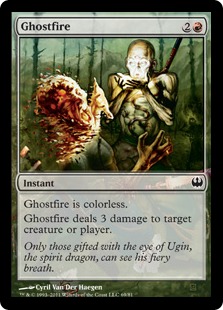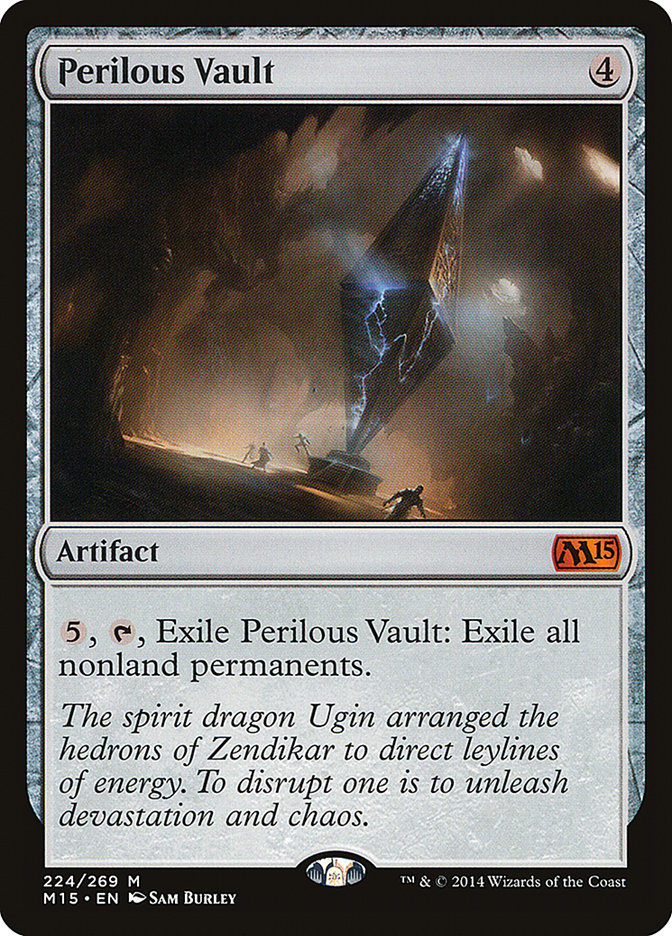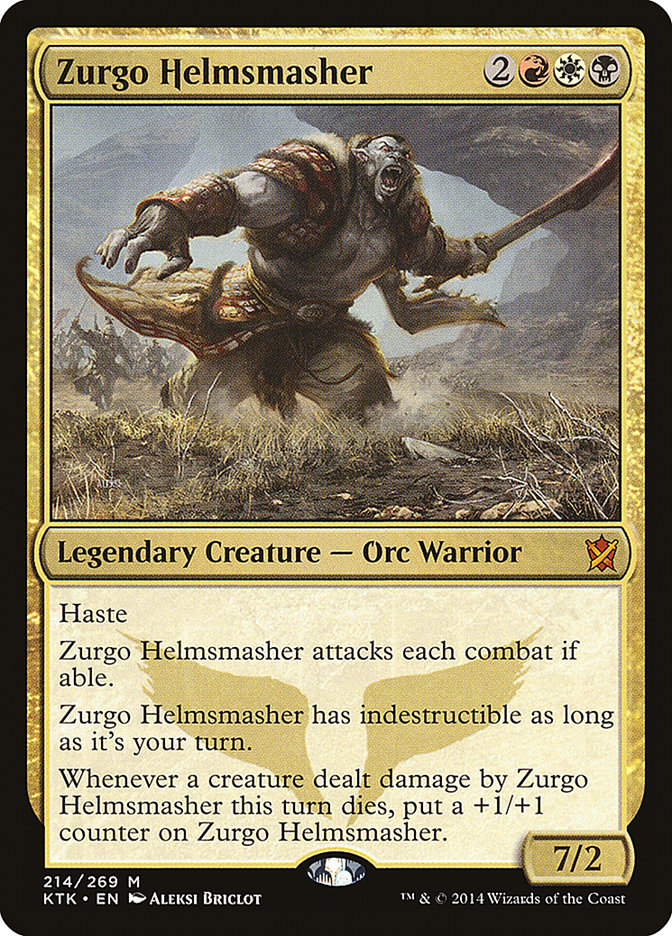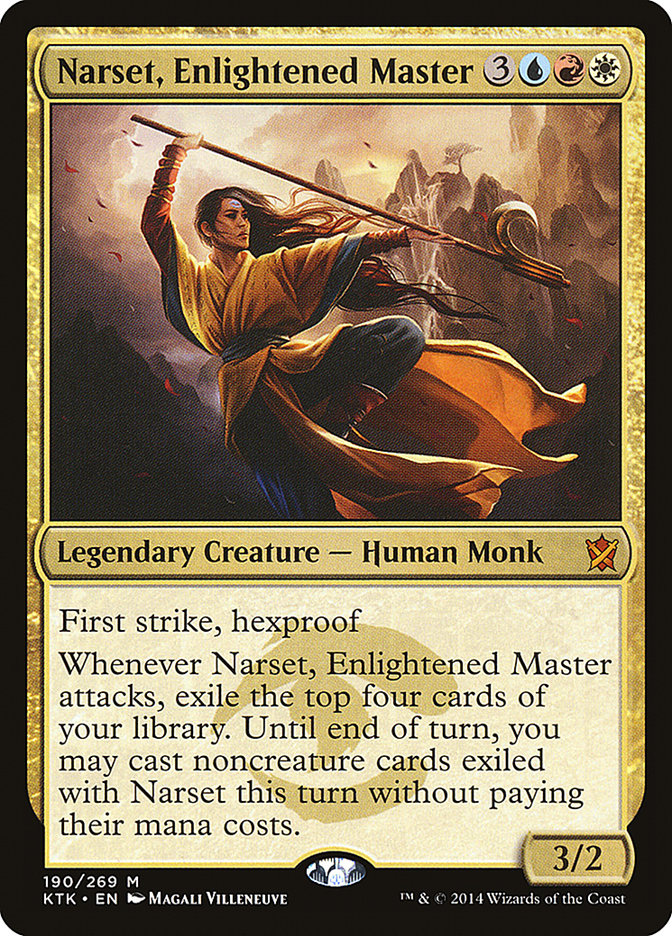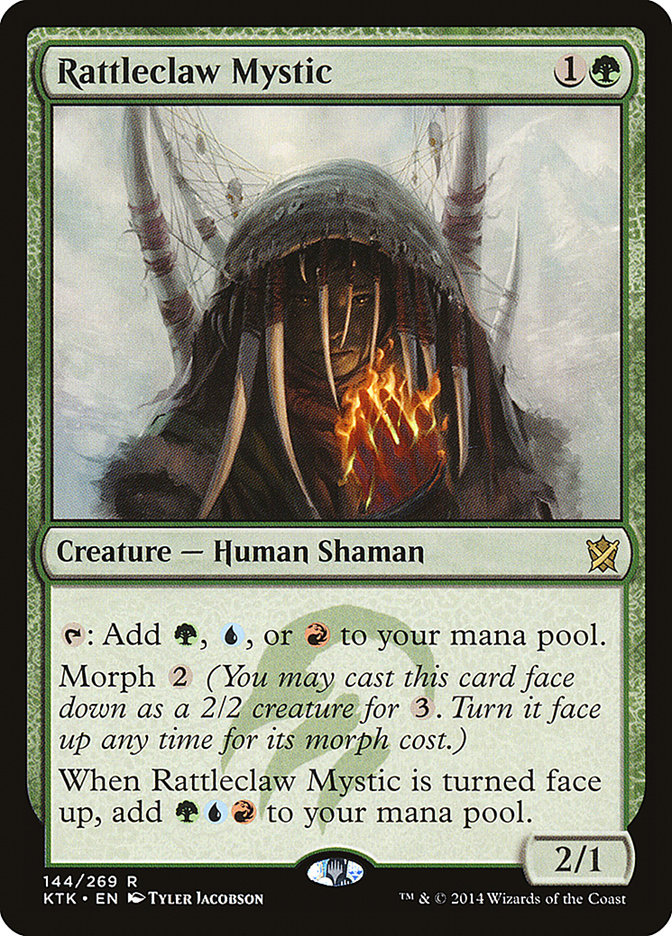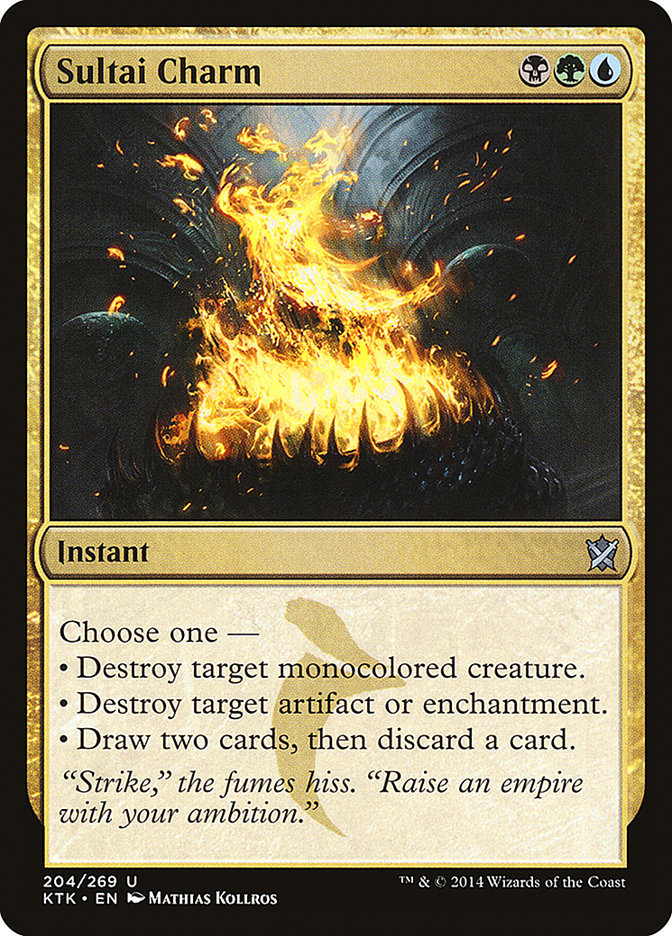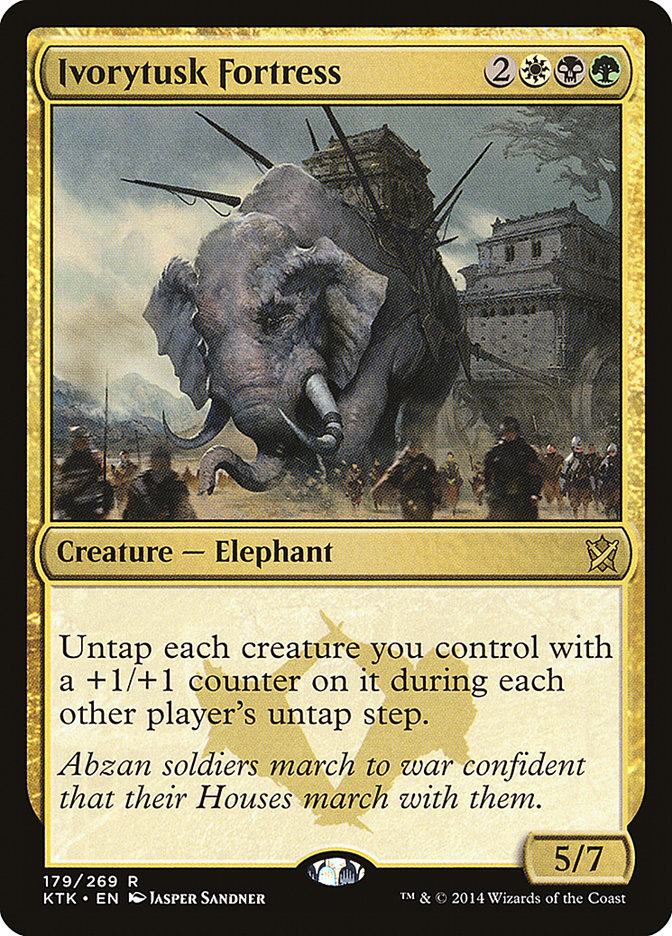The early Khans of Tarkir previews are in. There was a jolly fun worldbuilding panel at PAX Prime.
The fetchlands originally printed in Onslaught Block are back.
There’s lots to talk about with these early glimpses of the plane of Tarkir, but first I’m going to get a little meta. There wasthis other announcement by Mark Rosewater on 25 August, and while others have discussed some of the consequences, I want to focus specifically on
the consequences for the Creative side of Magic R&D.
Prose and Khans
Mark Rosewater, who is in R&D but not full-time on the Creative side, had a couple of observations about the block structure change that he posted on
Tumblr.
He knew about the change eighteen months in advance (i.e. their usual product cycle time).
The creative team has expanded to accommodate the change from one block a year to two.
All of R&D takes on a certain burden with the change to two blocks a year, but Creative takes the brunt of it because there will be two worlds rather
than one. That means two style guides (double the Planeswalker’s Guides, effectively, since those are
adaptations of the style guides), two narrative arcs to plan…possibly two novels? Or two novellas, more likely, one per world. That’s one of the nice
things about e-publishing: novellas are commercially viable again.
As Mark Rosewater said: eighteen months. Let’s expand that a bit to two years. I’m actually kicking myself for not realizing that something was up as the
creative team transformed.
What’s happened with the creative team since August 2012? That’s when Colin Kawakami came onboard as Creative Manager. Jennifer Clarke Wilkes transitioned
from Dungeons & Dragons to Magic in January 2013, making her Uncharted Realms debut with the short story “Ruric Thar” in April. Ari Levitch came in on an
internship in February 2013 and stuck. In April 2013, principal creative designer Brady Dommermuth left Wizards ( with the words “my position has been eliminated”). Then there was the job ad
in July 2014 for a creative text majordomo, the wording of which I unfortunately can’t find anymore, though I did tweet my reaction:
If I weren’t happily employed with @starcitygames I’d be all over this @wizards_magic R&D Creative job listing. http://t.co/sQT5VYtGU3
— John Dale Beety (@jdbeety) July 11, 2014
For a team that isn’t terribly large (other confirmed members are Doug Beyer, Jenna Helland, Adam Lee, Ari Levitch, and…hmm…probably at least a person or two I don’t know, so
sorry, other people!), that’s quite a shakeup in a span of two years. It wasn’t all addition either, with Brady Dommermuth’s departure. Starting with Khans
of Tarkir and especially in the following block, it will be interesting to chart how the creative elements of the game change with the shift in personnel.
A look back at the tenor of Uncharted Realms might also be worthwhile.
That’s enough inside baseball. On to my early impressions of Khans of Tarkir!
Early Impressions of Khans of Tarkir
Before going any further, there’s some essential reading (and viewing).
Mark Rosewater’s Labor Day article
has valuable insight into the creation of the block, both mechanics and setting.
The Khans of Tarkir Card Image Gallery is the source for official spoilers.
The official Khans of Tarkir trailer:
While the official recording of the PAX worldbuilding panel isn’t up as I write this, the panel is another key text, and I’ll be referencing it a lot.
Major takeaways from the PAX worldbuilding panel and other sources:
Sarkhan isn’t a product of the plane of Tarkir so much as Tarkir is a product of Sarkhan; that is, Sarkhan came first, and then the world he would’ve come
from was imagined around him. Tarkir serves Sarkhan and his story; that’s the reason, for example, that all dragons are extinct.
That ghostly dragon hanging out with Sarkhan isn’t Nicol Bolas but
Ugin, the spirit dragon who was first seen dishing out Ghostfire in Future Sight and later was identified as one of the Eldrazi-imprisoning trio of
planeswalkers who temporarily made the Multiverse safe millennia ago with their acts on Zendikar. Ugin died on the plane of Tarkir, and his physical
remnants have lain there ever since. Nicol Bolas choosing a planeswalker from Tarkir to guard Zendikar’s Eye of
Ugin was both ironic and arrogant, and if the usual pattern of storytelling holds, the choice soon will bite Bolas in his draconic behind.
So Sarkhan, one of the planeswalkers responsible (albeit unwittingly) for unleashing the Eldrazi on the Multiverse, is mentally “nudged” by the phantom of
Ugin toward the place where the spirit dragon’s bones lie. Sorin Markov, who was part of the stop-the-Eldrazi trio, also has come to Tarkir because nobody
else showed up to Sorin’s “we have to stop the Eldrazi again” party. Ugin, of course, had a pretty good excuse for not showing…not that that’s any
comfort to Sorin.
(Sidetrack: Viktor Titov, the Russian illustrator of Bitter Revelation, is new to Magic. Here’s his CGSociety page. Other artists not previously seen in Magic but credited for work that
appeared at the PAX worldbuilding panel:
David Gaillet – illustrator from Toulouse, France. His Facebook page is a bit too questionable to link on this family site.
Torstein Nordstrand – illustrator from near Bergen, Norway. More than one piece of art on his Webite
feels “Khans” to me.
Sam Keiser – illustrator living in the Seattle area. Here’s his LinkedIn page. Young,
still forming, and already pretty good. Was part of the concept push, generating sketches and other style-guide content. I’m curious to see how he
develops.)
Back to the storyline…
Like most (all) sapient beings on Tarkir, Sarkhan was a member of a clan, specifically the Mardu. They’re the Red-centered clan with Black
and White complements, revering the speed of the dragon with wings as their symbol, inspired by (though not a direct copy of) the famous Mongol warlords of
ages past (think Genghis Khan who, in one tale told of him, died after taking an arrow in the knee). Sarkhan didn’t exactly leave on good
terms–being a general and then blowing up your whole army for shamanistic purposes will do that–so he and reigning Mardu khan Zurgo Helmsmasher
have more beef than Brazil.
Speaking of Zurgo, he’s an orc. In Magic, orcs haven’t been seen outside of super-early sets, nostalgia sets (Coldsnap, Time Spiral), core sets, and
Un-sets. There’s definitely a nostalgia kick at play. Also vaguely nostalgic: goblins. (Admit it…you missed them in Theros block.)
Now, the Jeskai are centered in Blue with components White (looking back: see above and how the Mardu are Red-centered and “look back” to
Black) and Blue-White’s common enemy, Red. They revere the cunning of the dragon, and their symbol is a dragon’s eye. With their wandering monk and “mystic
discipline” theming, the Jeskai give off a wuxia vibe, kicking tail and taking names with
acrobatic style.
That’s not where the Jeskai’s inspiration ends though. The Jeskai also have graceful aven, a Magic-distinctive species of bird-humanoids that first
appeared in Odyssey block; djinn and efreet, throwback creature types borrowed from Arab mythology (think Arabian Nights); and the most advanced
techno-golems (golems coming from Jewish folklore) on the plane to guard the monasteries. It’s a heck of a mishmash, and I’m eager to see if the creative
team pulled it off.
The Temur, centered in Green with look-back ally Red and their mutual enemy Blue, revere the savagery of dragons and have adopted the claw
for their symbol. These are Tarkir’s ice-people. Think the Taiga dual land and thehistorical shamanistic practices first documented in the West when the Russian Empire toppled theKhanate of Kazan; there was also a Siberian Khanate for good measure.
The Temur have “ice goblins.” They summon elementals. They have ogres and the plane’s brand-new canid species (creature type “hound”), the latter
thick-furred to ward off the persistent cold. They also punch bears.
The Sultai have taken the ruthlessness of dragons and their fangs for themselves. Stylistically rooted in Southeast Asia (the PAX
worldbuilding panel specifically called out the Cambodian ruin Angkor Wat), the Black-centered Sultai
look back to Blue and their common enemy Green. There are cat demons, crocodile pits, and vampires, and the Sultai mechanic is Future Sight’s delve, seen
on Tombstalker and a couple of other cards.
Ruling the Sultai are the naga, boss snake-humanoids derived from a class of snake-deities that have
been “borrowed” by Western popular culture, most notably in the Warcraft series. Between the naga and the generally Asian-inspired setting, one might be
forgiven for thinking that World of Warcraft: Mists of Pandaria,
released in September 2012, was the pop-culture “green light” to go ahead with the Tarkir setting in much the same way thatTwilight was a signpost for Innistrad.
Last (or should that be “outlast?”) are the Abzan, centered in White with a “look back” to Green and mutual enemy Black. At home in the
desert called the Shifting Wastes with magic that can call upon the sands themselves, the Abzan are built for permanence and defense, taking the dragons’
endurance and scales for themselves. Scales are key to the appearance of Abzan armor, among other visual markers. Whether their forts are stationary
outposts or traveling fastnesses complete with ancestor-spirit battle trees, the Abzan are always ready for the long haul.
Speaking of visual markers, the sapient non-humans of the Abzan are shaped by their environment: the Abzan aven are bald-headed like carrion birds, and
their hound-people draw inspiration from jackals. The Abzan even have a few orcs, a lineage derived from orphans picked up after an Abzan victory.
In the Q&A session that wrapped up the worldbuilding panel, an audience member noted that Tarkir was the first time Magic’s stepped outside a Western
Europe-rooted world in a while, also noting that of the five khans, three (Jeskai, Sultai, and Abzan) are women. A panelist noted that this was a conscious
decision and stated specifically: “We want the Multiverse to be a diverse, complex place.” The optics could’ve been better–the worldbuilding panel was
all-male, which doesn’t even reflect the makeup of the brand and creative teams–but for the concrete steps Wizards has taken, like specifying genders in
art descriptions to ensure equal representation, I will give the credit due.
That’s the early word from Khans of Tarkir. Now, if you’ll excuse me, there’s a bear who requires urgent medical attention…

